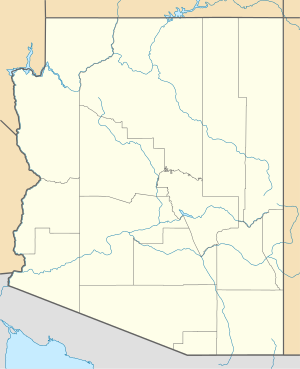Big Sandy River (Arizona)
| Big Sandy River | |
| Country | United States |
|---|---|
| State | Arizona |
| County | Mohave, La Paz |
| Source | Between Hualapai and Aquarius ranges |
| - location | East of U.S. Route 93 near Hualapai Indian Reservation, Mohave County |
| - elevation | 2,435 ft (742 m) |
| - coordinates | 34°55′21″N 113°37′37″W / 34.92250°N 113.62694°W |
| Mouth | Bill Williams River |
| - location | Alamo Lake State Park, La Paz County |
| - elevation | 1,237 ft (377 m) |
| - coordinates | 34°18′38″N 113°31′36″W / 34.31056°N 113.52667°WCoordinates: 34°18′38″N 113°31′36″W / 34.31056°N 113.52667°W |
| Length | 55.7 mi (90 km) |
| Basin | 1,988 sq mi (5,149 km2) |
The Big Sandy River is both an intermittent and perennial stream in Mohave and La Paz counties in northwestern Arizona in the United States. It begins where Cottonwood Wash and Trout Creek converge in the Hualapai Indian Reservation east of U.S. Route 93 then flows past south of Kingman. The Big Sandy River then passes the Signal Ghost Town Site, meanders through the Arrastra Mountain Wilderness, and joins the Santa Maria River in Southern Mohave County to form the Bill Williams River. The Bill Williams River then empties into Alamo Lake State Park. The Big Sandy River is 55.7 miles (89.6 km) long.
The Big Sandy drainage basin covers approximately 2,000 square miles (5,200 km2) in Mohave, La Paz, and Yavapai counties. The Hualapai Mountains are west of the river, and the Aquarius and Mohon Mountains lie to the east and southeast, the Juniper Mountains further east, and the Peacock Mountains and Cottonwood Mountains to the north. Hualapai Peak at 8,417 feet (2,566 m) is the highest point in the basin. The river flows through the Arrastra Mountain Wilderness.
The Big Sandy River flows year-round (perennial flow) south of the Signal Ghost Town site and intermittently above this site. In the period of 2007-2016, the surface water flow of the Big Sandy at the USGS monitoring site at the Signal Ghost Town ranged from a minimum of 22 US gallons (83 L) per second to a maximum output of nearly 524,000 US gallons (1,980,000 L) per second during flooding in early 2010.
...
Wikipedia

